Tennessee includes some of the tallest mountains in the Eastern United States, as well as fertile and scenic lowlands and culturally important cities. The state is varied, well-watered, and mostly warm. Perhaps not surprisingly, it’s a good place to hunt mushrooms.
This list is just a beginning and not to be used instead of a field guide, spore prints, or an identification app. If you go looking for mushrooms and are going to consume mushrooms, make sure you use a local expert and take a quality knife with you and a basket/bag for your finds!
Our Recommended Field Guides in Tennessee
COVER | TITLE | Header | ||
|---|---|---|---|---|
OUR #1 RATED | ||||
Edible Wild Mushrooms in Tennessee
We won’t try to list all of Tennessee’s edible mushrooms (there are too many). Instead, we offer an introduction to a few of the more interesting possibilities. It’s often said that people wanting to eat wild mushrooms should get all their identifications confirmed my experts. That’s not because mushroom identification is especially difficult. It’s not. But very few of us have any experience with mushrooms, and a lack of familiarity with anything makes distinctions harder to notice. It’s also difficult for beginners to know which mushrooms are especially difficult or risky.
So yes, consult an expert. It’s safer. But don’t think mushrooms are hard to learn. You could be an expert yourself before too long!
Chicken-of-the-Woods (Laetiporus sp.)

Chicken-of-the-woods is usually described as the one, reliably edible species that anyone can identify. Such statements are almost completely false. For years it’s been known that some people sometimes get sick from eating these mushrooms. Much thought was put into trying to find out why, and much guidance on when to avoid chicken was developed. The real answer seems to be much simpler: there is more than one chicken in them thar woods.
Chicken-of-the-woods isn’t a species at all. It’s a genus, albeit one not fully defined yet. Some members of the genus are safe to eat and excellent, others are a bit tough, and still others are mildly toxic. We can’t find confirmation of which chicken species live in Tennessee, but some of them certainly do. Eating them requires caution and some further research, but could result in an excellent meal. When Chicken of the Woods is referenced it is generally talking about Laetiporus Sulphureus.
Crown-tipped Coral Fungus (Artomyces pyxidatus)
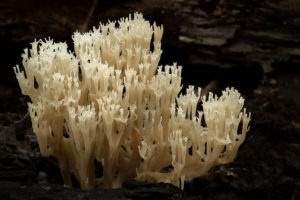
Reportedly[i] these are nothing special as far as taste, but given a chance to try something this odd-looking, who would say no? These are named for the tiny extensions on the tip of each branch that look like the points of a crown. There are many other edible coral fungus species besides this one, but there are also inedible species, so proper identification is important.
Morels (Morchella sp.)
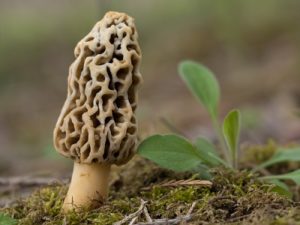
Morels are a group of distinctive and delicious mushroom species, notable for their narrow, pitted caps that are fused, partly or wholly, to their hollow stems. Oddly, although “everybody knows” morels are safe to eat when properly cooked, even cooked morels do make some people sick—and nobody is really sure why, yet. It may have to do with individual human sensitivity, so it’s probably best not to eat too many at once until you find out how they do with your system.
Unfortunately, it’s difficult to find out which morel species live in Tennessee. Most references just call them morels, without specifying, plus many morel species are either variable or similar or other morel species or both. As a result, many common names, such as Yellow Morel and Black Morel, refer to multiple species, while some species have multiple common names. Some morel species haven’t even been properly named yet.
Jackson’s Slender (Amanita jacksonii)

Jackson’s[ii] is part of a complex of American mushroom species that all closely resemble the European Caesar’s Mushroom. Besides looking alike, they are similar in being safe to eat and reportedly quite tasty. The taxonomy of the group is still being worked out.
The trick with the edible Amanitas is, of course, to never confuse them with the poisonous Amanitas, some of which can kill. The closest similarity is probably to fly agaric (Amanita muscaria) which differs from Jackson’s largely in having white warts—but the warts can fall off. Fly agaric is seldom deadly, but poisonings can be deeply unpleasant. Proper identification requires careful attention to detail, so most experts advise beginners to skip Jackson’s for now.
Puffballs
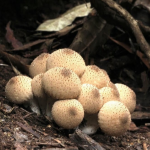
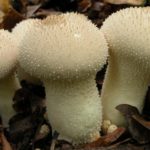

Puffballs aren’t a species or even a genus. Rather, they are a growth-habit; some species produce ball-shaped fruiting bodies that puff out spores when fully mature. Most puffballs aren’t closely related to each other, they just look vaguely alike. Most are edible when young, and the exceptions are fairly distinctive—though many do resemble Amanitas in their “egg” stage, and must therefore be sliced vertically and examined carefully before going to to the table so as to avoid a potentially deadly mistake.
Tennessee has at least three species:
Stump puffball (Apioperdon pyriforme) is shaped like an upside-down pear, fruits in huge groups, and usually tastes pretty mediocre[iii].
Common puffball (Lycoperdon perlatum)[iv] has a short, thick stem—the overall shape is somewhat like a town water tower—and is often covered by short, blunt spines. It’s a popular edible.
Giant puffball (Calvatia gigantea)[v] is so big, it can’t be confused with anything else, except perhaps an albino watermelon. It, too, is a popular edible, it’s main drawback being that it goes bad quickly at room temperature but is too big to fit in the fridge. It does dry well, making a powder with many culinary uses[vi].
Magic Mushrooms in Tennessee
The main problem with harvesting “magic” mushrooms is the threat of legal trouble. Psilocybin (the “active ingredient” of many of these mushrooms) is illegal according to both US and Tennessee law. Penalties can be severe. There may be some movement towards legalization in the state, but that movement has yet to bear any fruit.
The other main problem is the existence of some deadly-poisonous look-alikes, such as the Deadly Galerina. Identification must be extremely rigorous and well-informed, because people sometimes die from harvesting the wrong mushroom.
The right mushrooms are still not risk-free to use, but they are relatively safe.
Tennessee has a variety of psilocybin-containing mushrooms[vii]. Most are low-potency, but there are exceptions.
Fly agaric (Amanita muscaria) also lives in Tennessee and is psychoactive, though it does not contain psilocybin. It’s quite different biochemistry provides a qualitatively different high—if prepared properly. If not prepared properly, it will make the eater very, very sick. It’s not usually deadly, but fatalities have been recorded.
Gymnopilus sp.
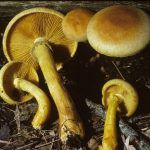

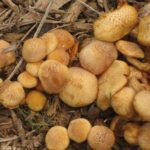
There are a few psychoactive species in the Gymnopilus[viii] genus, but they aren’t popular so few trip reports have been published. Tennessee’s three species are G. luteus[ix], G. luteofolius, and G. aeruginosus.
Panaeolus sp.
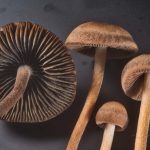
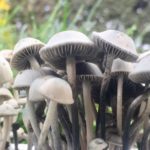
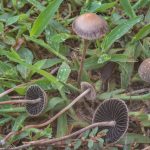
Panaeolus mushrooms, or pans, are also called Mottlegills, since their spores mature and darken in patches. Some authorities have separated the psychoactive members of the genus and put them in a new genus, Copelandia. By whatever name, Tennessee has three species. The Banded Mottlegill (P. cinctulus),[x] named for the pale band around the rim of its cap, is of very low potency (which is what some people want). The Blue Meanie (P. cyanescens)[xi] is one of the most potent “magic” mushrooms known—it should not be confused with the cultivar of Psilocybe cubensis, also called “blue meanie.” The Turf Mottlegill (Panaeolus fimicola) is sometimes included in Tennessee’s list, too, but is only weakly active and may also be mildly toxic[xii].
Psilocybe
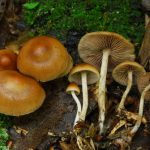
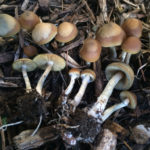
Psilocybe is the genus of possibly the most wildly-cultivated “magic” mushrooms in the world, P. cubensis. Cubes do grow wild in Tennessee, as do two other species that share the common name, blue foot: P. caerulipes[xiii] and P. ovoideocystidiata[xiv]. The latter is notably larger.
Poisonous Mushrooms in Tennessee
Again, this list[xv] is not exhaustive—the fact that a mushroom isn’t here doesn’t mean it’s safe to eat! But these are some of Tennessee’s most notable poisonous residents.
Destroying Angel (Amanita sp.)
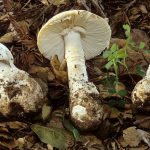
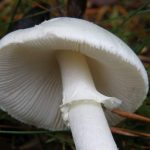
There are multiple Destroying Angel [xvi] species within the Amanita genus. It’s hard to tell them apart but usually one of Amanita bisporigera, Amanita ocreata or Amanita virosa is being referred to as Destroying Angel. All of them are handsome white or whitish mushrooms that contain enough toxin to kill almost everybody who eats one. They don’t have a lot of close look-alikes except each other, but they can be mistaken for almost any white mushroom, including some pf the puffballs, by foragers who neglect to check certain details. It’s not entirely clear which destroying angel Tennessee has, since the taxonomy is still being worked out, but the main point is not to eat them.
Deadly Galerina (Galerina marginata)

The Deadly Galerina[xvii] has the same toxin as the Destroying Angels and likewise kills most of those who eat it. It is small, brown, and nondescript, just like a long list of mushrooms many people want to eat, including several culinary species and most of the “magic” mushrooms. Worse, it shares its habitat with some of its look-alikes and can grow mixed-in with them. Careful identification of every single mushroom is critical.
Jack O’Lantern (Omphalotus illudens)
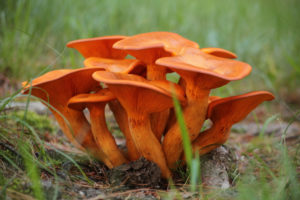
Jack o’Lantern Mushroom[xviii] is not usually deadly, but it will make eaters extremely sick. Being very orange, it is sometimes mistaken for orange or yellow edible mushrooms, even when the resemblance is otherwise slight. The species’ other claim to fame is that its gills glow in the dark, but the glow must be faints as many people insist they can’t see it.
False Parasol (Chlorophyllum molybdites)
This species[xix] belongs to a group of large, parasol-like mushrooms that are edible sometimes and poisonous other times. It’s the most poisonous of the group, to the point that it is not at all worth eating, but it doesn’t make everybody sick—just most people. Usually, it’s eaten accidentally by people who mistake it for one of the safer parasols or for any number of white or whitish edible species.
False Morels
False morels are a group of species whose wrinkled caps vaguely resemble the pitted caps of morels. They are all more or less toxic. This species is one of the most morel-like of the group—but it’s also a popular edible in its own right. People knowingly eat it, on purpose, claiming that it is safe when cooked properly. There are a number of problems with that claim, including the fact that one of the mushroom’s toxins, the one that doesn’t cook out, is cumulative. It’s possible to eat this thing for years with no symptoms while the poison builds up before suddenly taking effect.

My name is Austin Collins.
I've dedicated my life to Mushrooms.
I believe Mushrooms are the best kept secret when it comes to health and well being.
For that reason, I would like to share a company with you that in my opinion makes the best mushroom products on the market.
The company is called Noomadic Herbals, my favorite supplement they make is called "Mushroom Total".
I take their products every day and they have helped me think better and have more energy. Give them a try.
-Austin
References:
[i] Bergo, A. (n.d.). Crown-Tipped Coral Mushrooms. Forager Chef
[ii] Collins, A. (n.d.). Amanita jacksonii: The American Slender Caesar Mushroom.
[iii] (n.d.). Lycoperdon Pyriforme Schaeff. –Stump Puffball. First Nature
[iv] (n.d.). Lycoperdon perlatum Pers. –Common Puffball. First Nature
[v] Hedgepath, R.(2016). Some interesting Fall Mushrooms. Tennessee State Parks
[vi] Bergo, A. (n.d.). Puffball Mushrooms. Forager Chef
[vii] (n.d.). Which Psilocybin Mushrooms Grow Wild in My Area? Shroomery
[viii] (n.d.). Gymnopilus. Wikipedia
[ix] Kuo, M. (2012). Gymnopilus luteus. MushroomExpert
[x] (n.d.). Panaeolus cunctulus. Philosophy
[xi] Barlow, C. (2021). Blue Meanies Mushrooms: A Guide to the Potent Panaeolus cyanescens. Double Blind Magazine
[xii] (n.d.). Panaelous firmicola (Pers.) Gillet –Turf Mottlegill. First Nature
[xiii] (n.d.). Psilocybe caerulipes. Philosophy
[xiv] Roderick (2019). Psilocybe ovoideocystidiata. Psillow
[xv] (2020). What Types of Mushroom Grow in Tennessee? Reference
[xvi] Illinois Department of Natural Resources (2021). Destroying Angel. Biodiversity of Illinois
[xvii] (n.d.). Galerna marginata. Illinois Mushrooms
[xviii] (n.d.). Omphalotus illudens (Schwein.) Bresinky & Besl—Jack o’Lantern. First Nature
[xix] (n.d.). Chlorophyllum molybdites—False Parasol. Texas Mushrooms

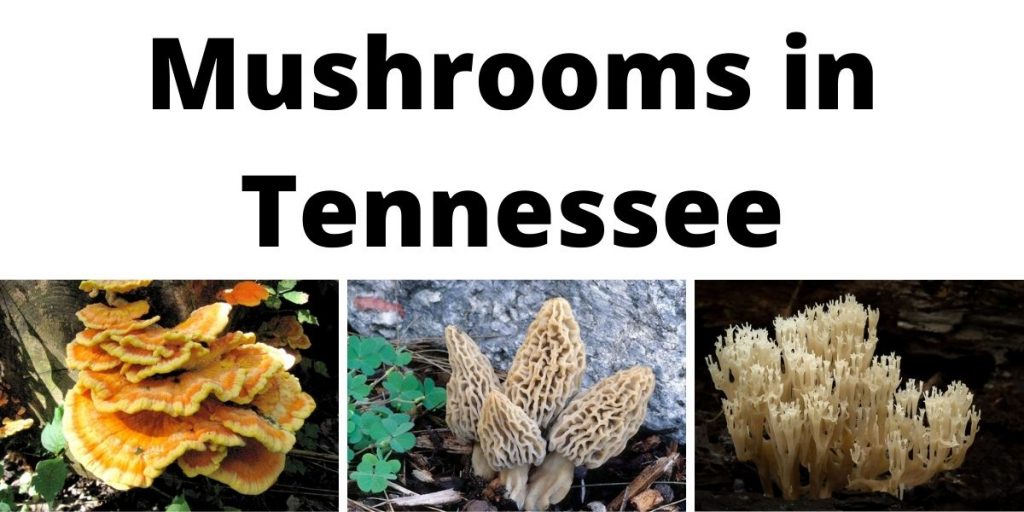
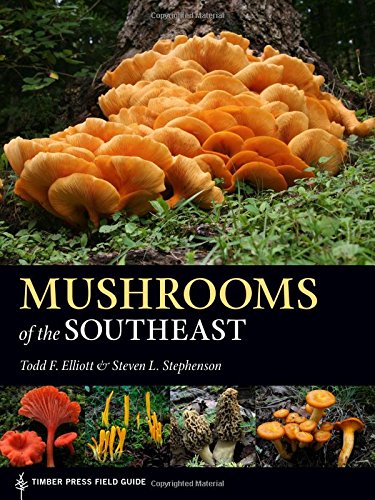
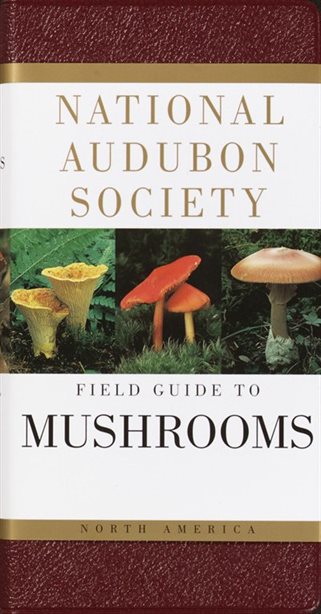

Very informative & interesting! Thank you.